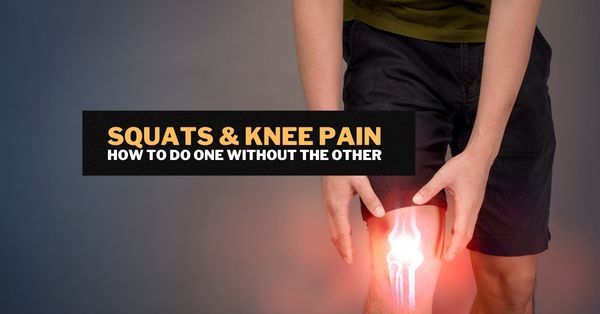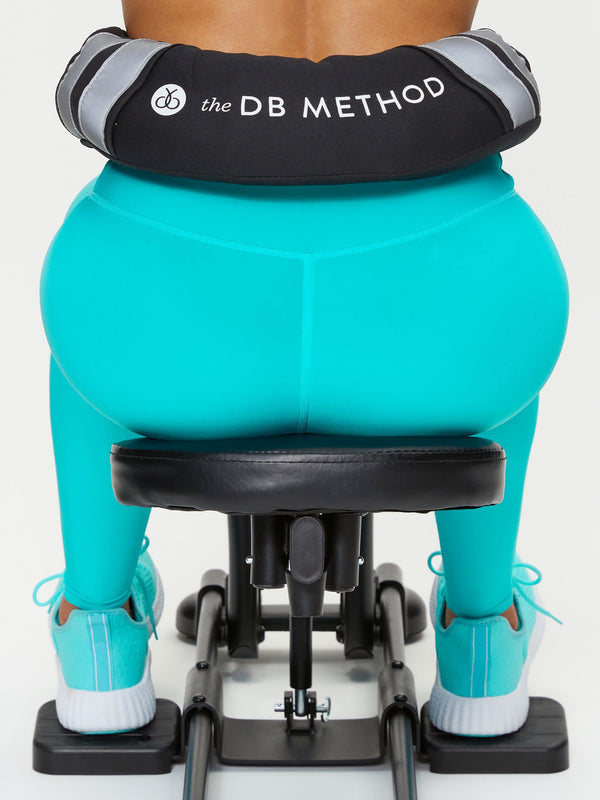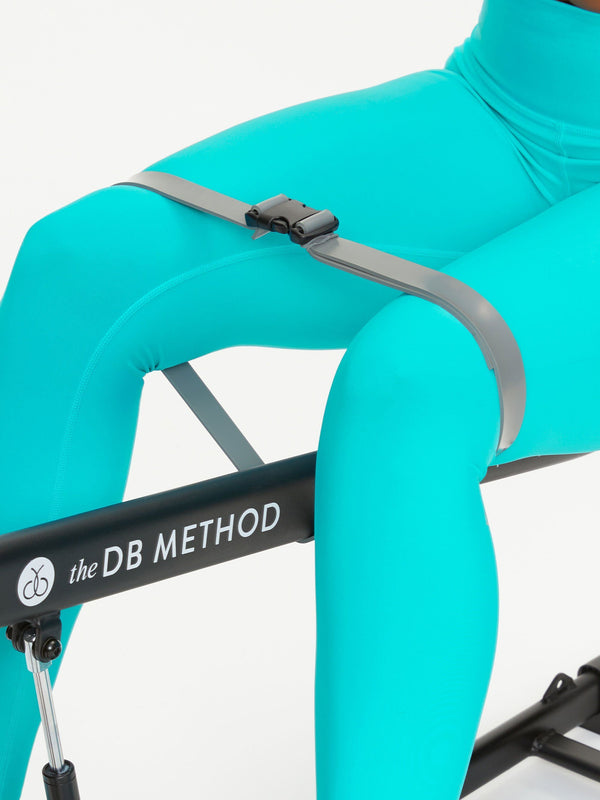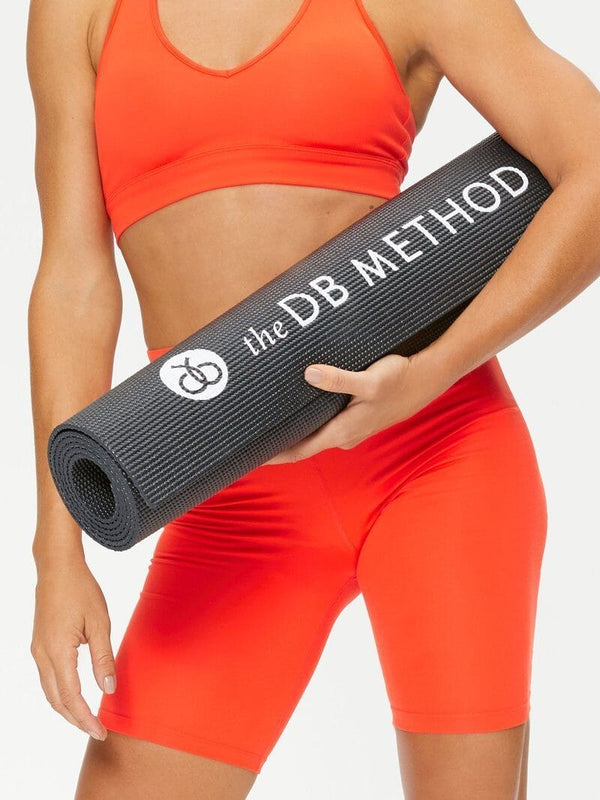While the saying goes “no pain, no gain,” that isn’t quite true. When you feel knee pain doing squats, you’re likely not holding the right form, re-activating injuries from sports or your childhood, or there is an underlying medical issue like arthritis. But good news, you can still do squats even if you have knee pain.
By modifying the type of squat that you do, using supports or a squat machine, or adding a few tweaks to your squat form, you can reduce the pressure on your knee or focus the strain onto other muscles. This all starts with the causes of the knee pain.
Common causes of knee pain are:
- Bursitis
- Fractures
- ACL Injury
- Torn Meniscus
- Tendon Injuries
- Iliotibial Band Syndrome
- Dislocation of your kneecap
- Arthritis
- Osgood-Schlatter disease
- Patellofemoral pain syndrome
Below you’ll find some examples of why each of these issues cause knee pain while doing squats, and a squat variation that is less stressful so you can continue to enjoy your fitness routine.
Bursitis
Bursitis is inflammation in your bursae, the small sacs of fluid that cushion the outside of your knee joints. It causes a mild ache, stiffness, and the feeling that your knee is locking up.
This occurs from repeated pressure on your knee doing activities like kneeling for long periods of time, or with athletes of sports with direct blows to their knees (like football and wrestling). When you have pain and stiffness from bursitis, your quads don’t work the way they should. Ball squats are a great option for people with bursitis.
The stress that a normal squat puts on your knees and your bursae is redistributed onto the ball. This helps to reduce the pain, but still lets you work your target areas.
Fractures
By strengthening the muscles surrounding your knee, you can alleviate the pain caused by a knee fracture while your doing squats. Look for squats that reduce the amount of strain on your knees so you don’t further exacerbate the knee fracture.
Mini squats strengthen your quads without adding pressure or stress to your fractured knee, which will help lessen your knee pain.
Pro-tip: You can help alleviate the pain caused by the fracture by strengthening the muscles surrounding your knee by doing mini wall squats while the bone heals.
ACL Injury
Your anterior cruciate ligament (ACL) can tear while playing sports that require sudden changes in direction (like basketball and soccer), which then cause knee pain. With this type of injury, you’ll want to do squat variations that place the lowest amount of force on your knee joint.
By starting with squats like the assisted hip dominant squat, you’ll get the “feeling” of squatting as you engage the same muscles, but you won’t apply as much pressure on your knee since this squat puts almost no strain onto your ACL.
Torn Meniscus
A torn meniscus usually occurs from trauma like a sports injury, degeneration from age, or a combination of the two. If you have a torn meniscus, the twisting and rotating of your knee while you do a squat is what is likely causing the knee pain.
Using a squat machine can help to keep you from twisting while holding proper form and help to minimize the stress and strain on your knee joint (which means less pain).
Tendon Injury
Tendon injuries can be caused from overuse (tendonitis) or degeneration (tendinopathy). Sports like volleyball, track and field, and basketball that do a lot of running and jumping have a higher rate of tendonitis. And tendonitis can be a result of aging. But this knee pain doesn’t mean you have to avoid squats.
Did you know that isometric exercises have been shown to reduce knee pain for upwards of 45 minutes? Single-leg isometric squats could be a great option if you have knee pain from tendon injuries, as they are isometric and allow you to shift the strain away from the inflicted area.
Iliotibial Band Syndrome
Iliotibial band (IT band) syndrome is normally caused by overusing your knees and excessive exercising. A good indicator of this is feeling pain on the outside of your kneecaps and surrounding muscles. Runners and cyclists have the most issues with this injury.
To help reduce the pain with IT band syndrome while doing squats, you can strengthen the muscles that surround the area (glutes, hamstrings, and quads). By strengthening the supporting muscles, they’ll engage while you squat and reduce the tension applied to your IT band.
Single leg wall squats engage and strengthen these other muscle groups and distributes the pressure away from your IT band. This makes them the best squat for knee pain caused by your IT band.
Dislocation Of Your Kneecap
Weak muscles around your knees and hips are one of the top causes of kneecap dislocation. If this is the cause of knee pain while squatting, variations that stabilize your knees will allow you to get the benefits of the squat without the strain on the dislocated kneecap.
Barbell squats improve the overall stability of your knee while strengthening the surrounding muscles (quadriceps, glutes, and hamstrings). This improved stability lessens, if not completely rids, your pain.
Arthritis
More than 100 different types of arthritis exist, and the varieties most likely to affect your knees are:
- Osteoarthritis (develops from wear and tear, most common in the 50+ age group, starts as a sharp pain when you move)
- Rheumatoid (autoimmune condition attacking your joints that causes pain, swelling, redness, and warmth, and is more common in younger people)
- Gout (High uric acid levels form crystals inside your joint and causes severe pain)
- Pseudogout (calcium-containing crystals develop in your joint fluid)
- Septic arthritis (your knee joint is infected and quickly causes extensive damage to your knee cartilage)
- Post-traumatic arthritis (develops after a knee injury due to damage, instability, or excessive wear and tear)
Half squats are the right choice for knee pain from arthritis.
Half squats strengthen the muscles on the fronts and backs of your thighs as well as your glutes, while minimizing the stress on your knee joint. Not to mention, they help increase your knee’s flexibility and strength.
Osgood-Schlatter disease
Osgood-Schlatter disease usually happens after growth spurts in kids between 9 and 14, and causes a painful bump below their knee. The pain is felt in the front of the knee, and over-exercising often makes this area hurt.
Since sumo squats require you to use more of your glute muscles and keep your knees from tracking straight forward, this reduces your risk of knee pain.
Patellofemoral Pain Syndrome
Muscle imbalance, tightness, and alignment issues with your legs usually cause the patellofemoral pain syndrome (otherwise known as runner’s knee). This is a dull, aching pain under your kneecap when you do a squat.
Decline single leg squats allow you to isolate your glutes, which takes the pressure off your knees. This should help decrease any knee pain you are feeling while doing squats.
We’ve got your back…well, maybe more your knees…because now you’re set to reduce or eliminate knee pain while you do squats.








